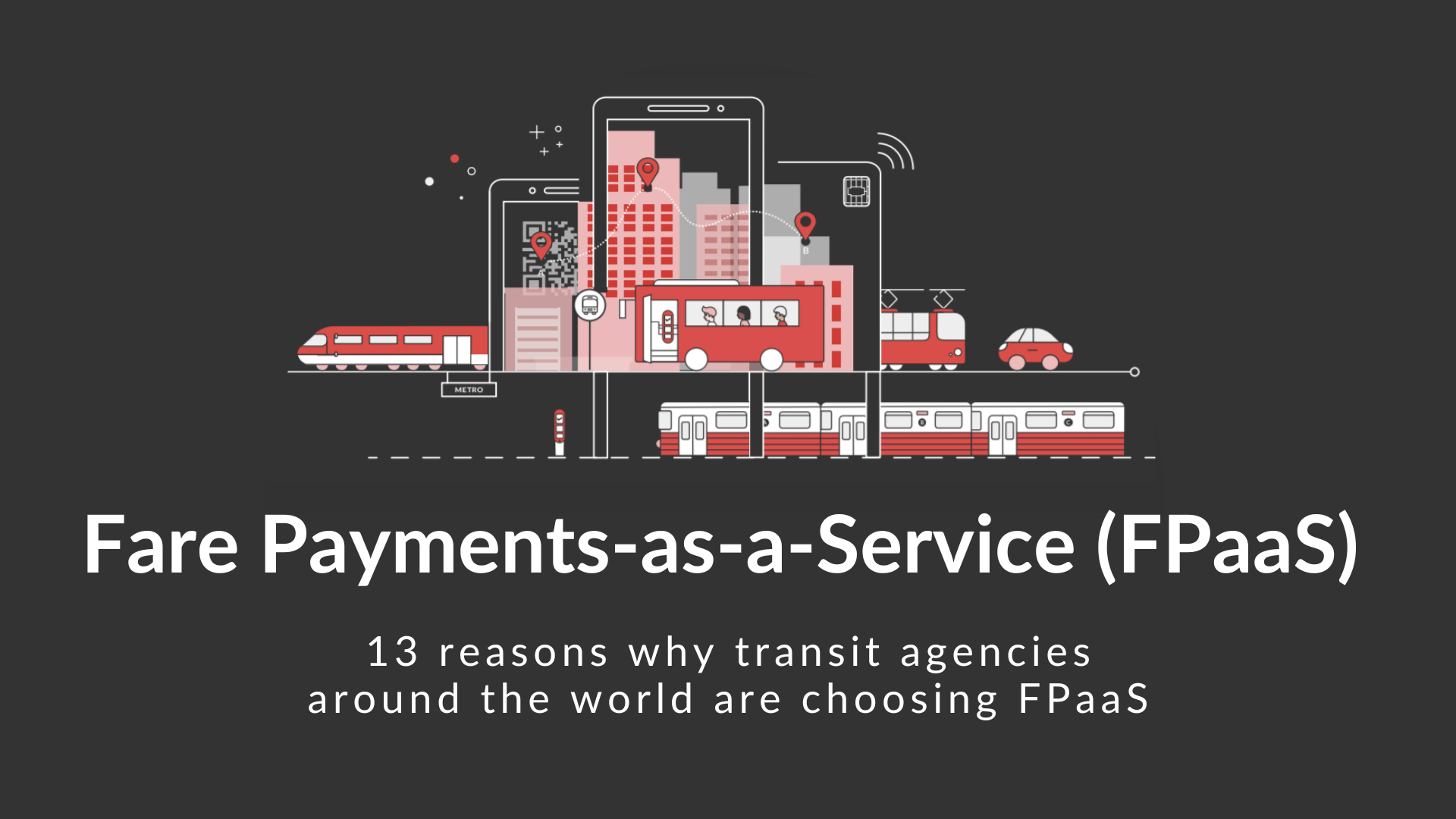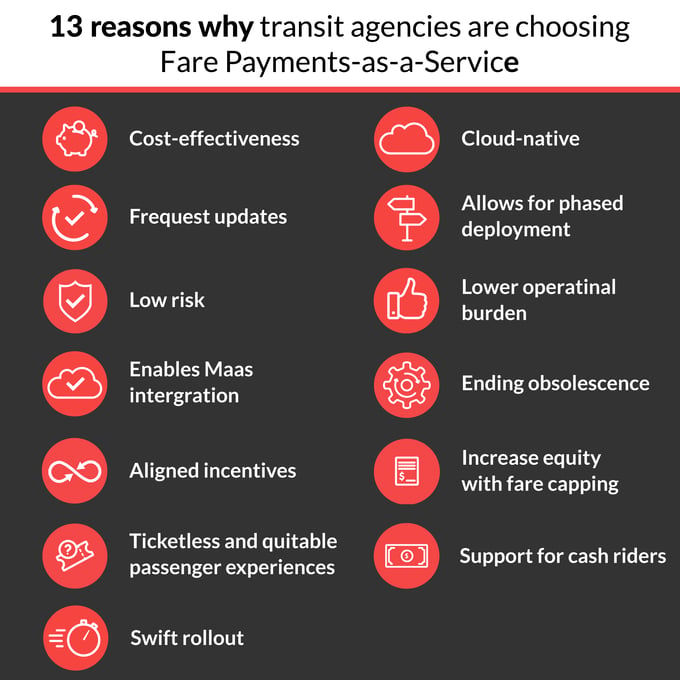Software as a Service (SaaS) platforms have transformed industries by providing ‘pay as you go’ software solutions across many different sectors to companies of all sizes.
From integrated accounting systems to retail sales, CRM and inventory management, many businesses now rely on Cloud-Native SaaS platforms which give them access to the latest technology on an affordable basis.
Mobile ticketing aside, transport ticketing systems were largely bypassed by this tech revolution, as there were no real shared platforms available to deliver complete solutions for cities via a SaaS approach. This changed a few years ago with the advent of ‘Fare Payments-as-a-Service (FPaaS.)’, or what some in Europe call ‘Ticketing-as-a-Service’.
We use the term ‘Fare Payments-as-a-Service’ because – in our view – the future of ticketing is not focused on issuing physical tickets or collecting cash, it's about enabling fares and payments (fare payments) via seamless 'tap and ride' mobility experiences for passengers while ensuring all rider groups are fully supported.
Today, it’s more important than ever to understand the different ways that state-of-the-art smart ticketing and fare collection technology can be implemented.
Forward-thinking transit agencies and operators are already taking advantage of the real-world benefits of Fare Payments-as-a-Service with the adoption of shared (multi-agency) platforms when replacing ageing bespoke ‘design and build’ Automated Fare Collection (AFC) systems.
Here is what you'll find out in this blog post:
- The 13 benefits of Fare Payments-as-a-Service
- How to get started with Fare Payments-as-a-Service
- The number 1 question to ask when selecting your next fare collection system
1. Cost-effective
Because Fare Payments-as-a-Service platforms are ‘shared’ or ‘multi-agency’ (multiple agencies all using the same platform and code), development and maintenance costs are shared across those agencies. As a result, transit agencies can considerably reduce the overall cost of fare collection thanks to reduced upfront and ongoing maintenance costs, resulting in a lower total cost of ownership of the system.
FPaaS solutions can usually be funded via a percentage of ticket sales revenue with low upfront costs because the system is already live and in use by other transit agencies.
2. Swift rollout
Because the basic software infrastructure is already live and is in constant use, plugging into it can be achieved very quickly. Masabi’s platform processed more than $920 million of fare revenue across more than 100 transit agencies around the world in 2019. So instead of undertaking an expensive and often protracted ‘design and build’ process, initial setup with FPaaS is more a case of configuring the pre-existing platform for the individual agency’s needs.
🔎Example: Fire Island Ferries, New York
In 2017 Fire Island Ferries partnered with Masabi to deploy an app-based mobile ticketing solution designed to speed up the boarding process. Fire Island Ferries used Masabi’s Justride end-to-end ticketing platform to launch their own mTickets app to solve their ticketing capacity challenges.
The Fire Island Ferries rollout was one of the quickest deployments ever delivered by Masabi, with everything concluded within just 23 days of signing the contract. Fire Island Ferries initially deployed the new ticketing system for the water taxi services on the island, with the ferries going live later in 2018.
This year, weekenders and vacationers in New York can book a ferry to Fire Island in the Uber app. The latest development uses Masabi’s public transit mobile ticketing Software Development Kit (SDK) to integrate seamlessly with Uber’s smartphone app. Users can simply open the Uber app, select FI Ferry Tickets and select the appropriate ticket for their trip.
READ MORE ABOUT MASABI’S WORK WITH FIRE ISLAND FERRIES
3. Frequent updates
Beyond the initial configuration, FPaaS platforms will continue to be automatically updated to handle new demands, integrate with new partners and add additional features and functionality. These constant updates help agencies keep up with the pace of technology change.
Because the entire platform exists in the Cloud, updates are smooth and seamless. Leading platform providers will produce and update a rolling roadmap of upgrades and new capabilities which will be rolled out to all the agencies using the shared platform.
On average, Masabi’s Justride platform updates three times a day. And all this happens seamlessly without the need for any costly change orders or reverse software engineering to ensure compatibility.
4. Cloud-native
Hosting an FPaaS solution in the cloud brings multiple dividends in terms of reliability, scalability and security.
Unlike Cloud-hosted platforms, Cloud-native platforms use software specifically designed to work in the Cloud, meaning the platform can scale quickly to handle peak demand during rush hours or large events.
And by using state-of-the-art servers running to the very latest security standards and the ability to switch on additional capacity in response to demand surges, Cloud-native platforms are less vulnerable to outages.
5. Low risk
The risks inherent in a design and build approach are significant. Each deployment is effectively a new, bespoke system usually taking years to design, build and implement. Bespoke systems are also trickier to ‘future-proof’: each new requirement, hardware update or piece of enhanced functionality usually involves significant additional costs and third-party integrations tend to be more complex and costly. With a Cloud-native platform, all these considerations are someone else’s responsibility, leaving transit managers free to focus on core operations.
6. Phased deployments
FPaaS solutions have an established roadmap of rolling out new functionalities and capabilities, allowing transit agencies to adopt a phased approach to implementation. The FPaaS journey could start with a relatively simple mobile ticketing module that could be fully implemented and evaluated before being built out to deliver a more comprehensive Account-Based Ticketing platform.
🔎Example: NEORide, Ohio, Kentucky, Michigan
NEORide is a partnership between 17 transit systems dedicated to developing and promoting accessibility, interoperability and improving the passenger experience across their collective services in Michigan, Ohio and Kentucky.
EZfare is a fare payment system run by NEORide – a first-of-its-kind innovative multi-agency ticketing offering, simplifying the experience for users and putting inter-agency collaboration at the core of ticketing.
The first step in EZfare’s journey to Fare Payments-as-a-Service was to launch mobile ticketing via the Justride agency-branded app and Masabi’s Justride Software Development Kit.
This allowed NEORide partners to integrate the app with Uber, Moovit and Transit apps – making it easier for riders to plan journeys and discover public transit choices.
By working with Masabi, NEORide was able to develop a roadmap to expand EZfare to include stored value, retail store cash rider support and onboard validation and – in the future – fare capping and smartcards.
Full Account-Based Ticketing is scheduled for rollout across the NEORide network, reaching another key waypoint on the roadmap towards comprehensive Fare Payments as-a-Service across counties and states within the NEORide transit area.
READ MORE ABOUT MASABI’S WORK WITH NEORide
7. MaaS-enabled
Adopting an FPaaS approach now opens up a pathway towards greater integration with MaaS apps down the line. It also allows agencies to adopt an Account-Based Ticketing model which enables riders to use stored value or contactless bank cards to tap and ride across multiple operators while ensuring they get ‘best value’ fares.
This makes it simple to integrate with the rapidly growing MaaS ecosystem (Uber, Moovit, Lyft, Transit) meaning the FPaaS approach – thanks to pre-integrated APIs – has the ability to put tickets in front of potential customers via the mobility apps they are increasingly likely to rely on.
By embracing both Software Develop Kits (SDKs) and open APIs, integrations with third-party systems are straightforward and in many cases the third-party partner takes responsibility for any development required to dovetail seamlessly. This makes it easy to partner and integrate with other best-of-breed MaaS innovations available both now – and in the future.
8. Lower operational burden
Designing and building bespoke systems to sell and inspect tickets can be a time-consuming and resource-intensive process. The 150-plus agencies who are using Masabi’s Justride FPaaS platform have realized operational efficiencies, freeing up staff to focus on adding greater value to the customer experience and resulting in happier customers AND staff!
The FPaaS approach also reduces the operational and resource burdens on the IT department because all the planning, design, maintenance and updates are taken care of by the platform operator.
9. Aligned incentives
Adopting an FPaaS delivery model means that our incentives to deliver an efficient ticketing solution are seamlessly aligned with our client agencies’ operational priorities. Agencies agree to pay a proportion of fare revenue to participating in the Justride platform, so if an agency can’t put tickets in the hands of its riders or collect fare revenue effectively, Masabi makes less money.
This provides a very focused incentive for us not only to deliver a seamless solution that maintains existing ticket sales capacity, but also to actively facilitate growth in ticket sales by maximizing convenience for all riders - for example by integrating with new payments technology as soon as it becomes available.
10. Ending obsolescence
Once deployed, traditional bespoke fare collection systems have a finite lifespan – after which their software code and hardware become commercially impractical to operate or update. We call this the ‘decay’ phase – normally entered 5-10 years after procurement – and the process of replacement is often fraught with risk, disruption and mounting costs.
Because shared platforms are updated continuously and have major new features added as the market adopts them, there is no reason why they would need replacing within any given timeframe.
This allows a transit agency to choose when to update or change their fare collection system – rather than having the decision forced upon them periodically as software is superseded or a key hardware component is no longer supported.
It also removes the onus on the agency to future-proof their solutions at the time of procurement, instead letting the shared platform adapt to changing technology and public expectations as these emerge.
11. Ticketless and equitable passenger experiences
The ticketing industry is changing rapidly as transit agencies move away from issuing physical tickets, to the convenience of riders bringing their own tickets using mobile phones, contactless bank cards and mobile payments – allowing them to simply tap and ride.
The next generation of public transport users will not want to be inconvenienced with buying a physical ticket in advance and they will increasingly expect whatever is in their pockets – whether that’s a smartphone or a bank card – to be their ticket to ride.
The future of ticketing is not about tickets; it’s about using an account-based back office to make the customer experience as smooth and seamless as possible – reducing the barriers of entry to public transit by removing the need to purchase tickets and select fares in advance. That’s why the best FPaaS platforms enable Account Based Ticketing.
The upshot of this transition will be more satisfied customers travelling more frequently using ticketing technology, which is cheaper for transport operators and agencies to introduce, maintain and upgrade.
FPaaS platforms also make public transit more equitable and accessible for unbanked and underbanked riders in two important ways: fare capping and cash digitization.
12. Increased equity with fare capping
Fare capping means that riders never pay more for their fare than they would if they bought the best value period pass, based on their usage of the system. When they spend the equivalent value of a daily or monthly pass on individual tickets within the defined period, they will not be charged again for further travel within that period. This means everyone using the system can benefit from discounts based on their use of the system – not their ability to afford paying upfront for a pass.
13. Support for cash riders
While cash payments will account for a diminishing number of fare transactions in the future, it is essential that transit agencies continue to serve riders who need to, or prefer, to pay cash for their transit tickets.
In order to benefit from the fare equity that fare capping brings, transit agencies need to make it easy and convenient for cash riders to convert their cash into mobility credits so they don’t need to pay when they board the bus.
So embracing new ticketing technology does not mean excluding cash riders.
Cash digitization enables unbanked or underbanked customers to convert cash into transit tickets or account credit via a variety of different transaction channels – online, at a transit agency’s travel center, at an automated ticket machine or a third-party retailer.
Masabi makes it convenient and straightforward for cash riders to top up their mobility accounts or pay for mobile tickets at popular retailers and convenience stores by linking with InComm Payments Vanilla Direct, Payzone and T-Cetra’s Vidapay retail networks.
Cash riders are further supported with the ability to pay cash for tickets or top up their account credit at automatic Ticket Vending Machines and at travel centers/ticket offices.
How to get started with Fare Payments-as-a-Service
One of the attractions of a FPaaS approach is the ability to start small and gradually build out a more ambitious and comprehensive system through a series of incremental steps – without having to design and build a system from scratch.
So a transit authority may, for example, choose to introduce an FPaaS solution within a ring-fenced area of the network – such as an express commuter bus service or even a local ferry service – to evaluate how operators and customers respond to new ticketing technology, or using a particular module like mobile ticketing, before rolling out a complete solution.
Many of Masabi’s established clients opted for a ‘toe in the water’ exercise before committing to a more comprehensive rollout.
🔎Example: Bustang, Colorado
Bustang is the Colorado Department of Transportation’s state-wide coach service – operating through the I-70 corridor between Glenwood Springs and Denver, and along I-25 between Fort Collins and Colorado Springs.
In 2017, Bustang launched a mobile ticketing app enabling riders to purchase and download single or multi-journey passes for up to 40 rides onto their phone. Riders simply activated their ticket prior to travel and showed the driver the virtual ticket on their phone when boarding.
Apple Pay and Masterpass were integrated as payment options a year later, meaning riders could pay in the app with a single tap. The app was then rolled out to regional Bustang Outrider services connecting Colorado’s major cities with rural communities earlier this year.
This step-by-step approach to implementing FPaaS solutions enabled Colorado Department of Transport to innovate and bed down FPaaS solutions on the Bustang service before extending them to the wider bus network.
READ MORE ABOUT MASABI’S WORK WITH BUSTAN
The Number 1 Question to Ask When Selecting Your Next Fare Collection System
Ticketing systems and the infrastructure which links agencies with operators, customers and – increasingly – third-party vendors or mobility apps like Uber or Transit are incredibly complex.
The pandemic has thrown up a whole bunch of new challenges, further increasing complexity and – in some cases – putting fare revenues under extreme pressure.
But the decision facing transit managers right now is actually pretty simple:
Do they pay large upfront fees for a 'Design-Build' fare collection system that will take years to go live and may quickly become outdated without expensive change orders?
OR
Do they commit a small slice of fare revenue to fund a shared platform, delivering innovation quickly, cost-effectively and with constant updates over the duration of the contract?
Read more about the FPaaS approach to ticketing.
To find out how Masabi can help your agency deliver the fare payments experience your riders will love, get in touch: contact@masabi.com



